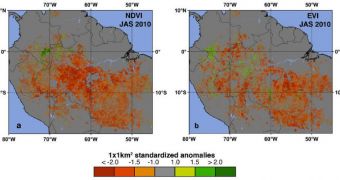Scientists with the American space agency say that one of their satellite managed to determine the extent of the damage caused by last year's record-breaking drought on the forests of the Amazon.
The study was conducted entirely from orbit, and was funded by NASA. Its main goal was to understand how this tremendously important habitat was modified as a result of the massive lack of water that affected the region with never-before-seen intensity.
At the same time, the need to study these effects is also motivated by the fact that not much is known about the way in which Amazon rainforests respond to droughts in general. As such, the new investigation had a double benefit, experts say.
Simulations and computer models were until now the only sources of data researchers had access to, but there was no way of determining whether the information was correct until it was verified by an actual study conducted in the field.
In past studies, it was determined that there is a rather large chance that rainforests in the Amazon will be replaced by grasslands or woody savannas, if climate change brings about warmer temperatures and shifts in precipitation patterns in South America.
This would be a catastrophic scenario, as the massive amounts of carbon dioxide the forests have stored within would be released back into the atmosphere. This would exacerbate the effects of global warming and climate change even further, scientists say.
The UN Intergovernmental Panel on Climate Change (IPCC) warned a few years back that one of the consequences of climate change will be an increase in the intensity and frequencies of droughts in the Amazon basin. These predictions, based on computer models, are now coming true.
“The greenness levels of Amazonian vegetation – a measure of its health – decreased dramatically over an area more than three and one-half times the size of Texas,” explains scientist Liang Xu.
“It did not recover to normal levels, even after the drought ended in late October 2010.” adds the Boston University expert, who was also the lead author of the new study.
For the new investigation, experts used the Moderate Resolution Imaging Spectroradiometer (MODIS) and Tropical Rainfall Measuring Mission (TRMM) instruments aboard the NASA Terra satellite.
The new work has already been accepted for publication in an upcoming issue of the esteemed scientific journal Geophysical Research Letters, which is edited by the American Geophysical Union.
“The MODIS vegetation greenness data suggest a more widespread, severe and long-lasting impact to Amazonian vegetation than what can be inferred based solely on rainfall data,” adds Atmospheric and Environmental Research Inc. expert Arindam Samanta, a co-lead author of the paper.
“Last year was the driest year on record based on 109 years of Rio Negro water level data at the Manaus harbor,” explains Federal University in Vicosa expert and study coauthor Marcos Costa.
“For comparison, the lowest level during the so-called once-in-a-century drought in 2005 was only eighth lowest,” concludes the expert.

 14 DAY TRIAL //
14 DAY TRIAL //